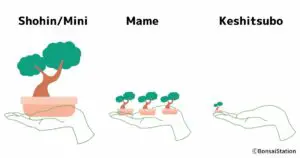We are all so remarkably attracted to rarity.
Rarity in bonsai can manifest in various forms, such as the scarcity of certain species, like the Buddha’s hand bonsai. Some bonsai are extremely small that are only finger-tip size while others live for a thousand years in tiny pots. Some bonsai trees are owned by historically significant figures such as samurai masters.
The world’s rare bonsai trees
Defining rarity in bonsai
Bonsai is the Art of Miniature Landscape: a natural landscape created with plants in a bonsai pot. A rarity in bonsai can be defined as the uniqueness and scarcity of certain bonsai trees, and it can be determined by the following factors:
- species
- age
- size
- style
- historical/cultural significance.
These factors make bonsai trees so rare and precious that you may be attracted to and seek them enthusiastically.
Rare bonsai species
One of the most important factors that determine the rarity of a bonsai is the species. Some bonsai species are rarer than others due to their limited range of growing conditions and/or relative difficulties in training them.
For example, tropical and subtropical bonsai species can be harder to find in colder regions, making them rarer. Those species include Buddha’s hand, beech-leaf prickly ash, olive tree, and bougainvillea.
Buddha’s hand bonsai
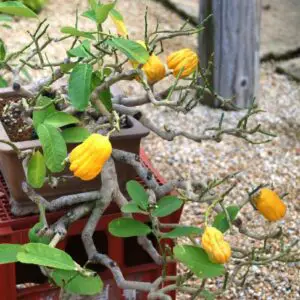
Buddha’s hand bonsai
Buddha’s hand (citrus medica var. sarcodactylus) is a cultivar of the citron fruit in the citrus family trees. It is native to northeastern India. The fruit is known for its unique, finger-like shape, which can resemble a hand or fist, thus its name.
Buddha’s hand is sometimes made into bonsai thanks to its interesting fruit shape and fragrance. As a citrus plant, it requires a lot of light and warmth to grow. Buddha’s hand tree is not a hardy tree as other bonsai species, and it will require specific care to keep it healthy even in a temperate climate.
Beech-leaf prickly ash bonsai
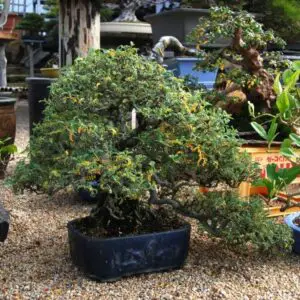
Beech-leaf prickly ash bonsai
Beech-leaf prickly ash (zanthoxylum beecheyanum) is a species of flowering plant in the citrus family. It is native to Taiwan and the surrounding islands and can grow to a height of around 25 feet. The tree is known for its unique leaves which have a strong, spicy aroma when crushed.
Beech-leaf prickly ash is sometimes used as bonsai because of its small, round leaves and bark texture, but it is quite rare and hard to find.
Olive tree bonsai
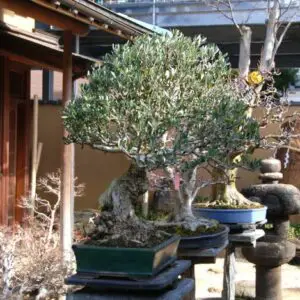
Olive bonsai
The European olive tree (olea europaea) is a species of tree in the family Oleaceae, which is native to the Mediterranean region. The olive tree is a slow-growing, evergreen tree that can reach a height of around 30 feet when planted in the ground.
Besides its use of fruit and oil, the olive tree is also cultivated as a bonsai. It has a gnarled trunk, twisted branches and glossy, green leaves which can be easily shaped. The olive tree is a long-lived plant and the oldest one known to humans is around 1500 years old. As such, you can take as many years as you want to achieve the desired shape.
Bougainvillea bonsai
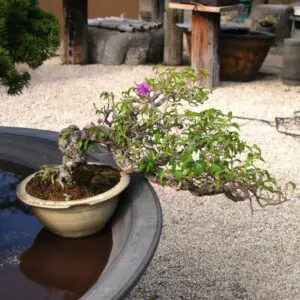
Bougainvillea bonsai
Bougainvillea is a tropical plant that is native to South America and is known for its vibrant, colorful bracts that surround small, inconspicuous flowers. As bonsai, Bougainvillea requires a warm and sunny location and high humidity and is thus rarer to find and hard to grow under a colder climate.
Extremely old bonsai
Another factor that determines the rarity of a bonsai is its age. The older the bonsai, the more valuable it becomes, not just for its historical significance but also for the skill that is required to keep it alive healthy, and maintain its shape.
Determining the age of a bonsai tree is very difficult. The simplest and most accurate way to determine its age is to count the number of the rings on the stump but it cannot be done without killing the tree. Other ways to determine the age of normal trees like measuring the size of the trunk are not applicable to bonsai trees. So, the age of most bonsai trees is just an estimate.
That said, there are several well-known very old bonsai trees in Japan.
1000-year-old spruce
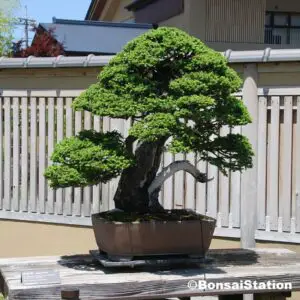
1000-year old spruce
This Ezo spruce bonsai is estimated 1000 years old. Ezo spruce (Picea jezoensis) is a Pinaceae family tree. It can live for a few hundred years in its natural habitat but is of course difficult to be alive and healthy for a thousand years in a tiny bonsai pot.
1000-year-old Japanese Shimpaku juniper
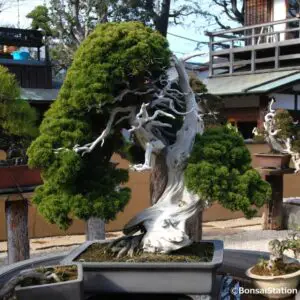
1000-year-old Japanese shimpaku juniper bonsai
This Japanese shimpaku juniper is about 1000 years old. Japanese shimpaku juniper (Juniperus chinensis var. sargentii) is a slow-growing species of juniper and known to live very long. This tree is very well-shaped, and was created and maintained by a famous bonsai artist, Kunio Kobayashi.
800-year-old Japanese shimpaku juniper
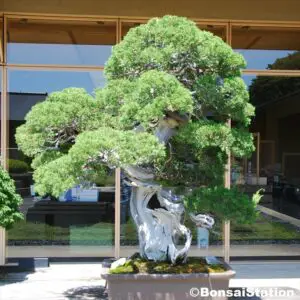
800-year-old Japanese shimpaku juniper
This Japanese shimpaku juniper bonsai is 800 years old and has remarkable shari (dead wood) flowing from the trunk to the branches, contrasted with the gray bark and the green foliage.
Extremely small bonsai
Size is another factor in determining the rarity of a bonsai. Miniature bonsai, which are smaller in size than traditional bonsai, can be considered rare because they require a high level of skill and patience to create and maintain.
Among small-sized or miniature bonsai, there are “Mame” bonsai and “Keshitsubo” bonsai. Keshitsubo bonsai is also called super-mini bonsai.
- Mini bonsai is one that fits in the palm of your hand.
- Mame bonsai is one that a palm can hold 3 pots.
- Keshitsubo bonsai is finger-tip size.
The mini bonsai are not only visually appealing but also require a high level of care and attention, making them a rarity. The most difficult part of their maintenance is watering. Because their pots are so small, the soil can be dried out easily and quickly, especially in summer.
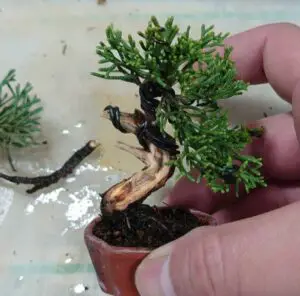
Mame bonsai
It is also difficult to maintain their size as well. As they grow, their trunk thickens slowly and outgrows to be mini bonsai trees.
All these make mame and keshitsubo bonsai rare.
Rare styling
The styling of a bonsai can also determine its rarity. As an art form that has developed over time, certain shapes and styles have become established as traditional and aesthetically pleasing. As such, unconventional bonsai styles are rare because they go beyond the norm of beauty expected in bonsai.
Literati style
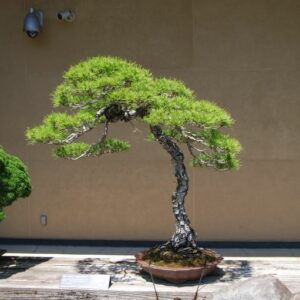
Literati style (traditional)

New literati style
The literati style is a style that is characterized by a long, slender, slightly slanting trunk with few branches and a sparse crown. Though traditional, bonsai trees with this style are relatively rare because it has to have a thin trunk that defies their growth as it gets older.
The new literati style in the picture has a long, slender, curved trunk with a few branches and leaves. It is a very interesting shape, eye-catching and expresses motion, and yet has a sense of stability.
Hollow style
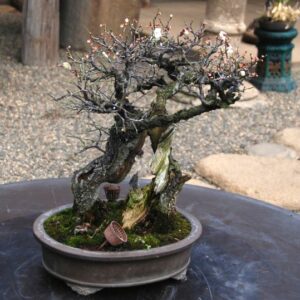
Hollow trunk
This plum tree’s middle trunk is completely hollow. We sometimes see this kind of tree in nature which gives a sense of old age with decay.
But it is definitely a rare style in bonsai because of its difficulty in making a hollow without killing the tree, by cutting away the middle trunk leaving only the outer layer. It certainly requires a high level of skill to create and maintain the tree’s health.
Having historical and Cultural Significance
Another factor that determines the rarity of a bonsai is its historical and cultural significance. Some bonsai trees have been owned by persons of importance in some ways, giving them cultural and historical significance.
“The Third Shogun”
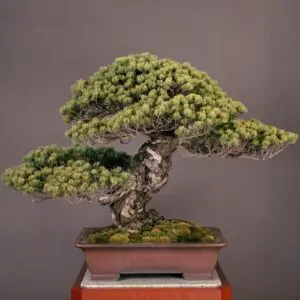
“The Third Shogun”, a 550-year-old Japanese white pine bonsai owned by the Emperor
For example, this Japanese white pine bonsai tree aged 550 years old is currently owned by the Emperor. It is believed that this tree has been treasured by the third shogun (tycoon) of the Tokugawa shogunate government about 400 years ago.
“Precious bonsai”
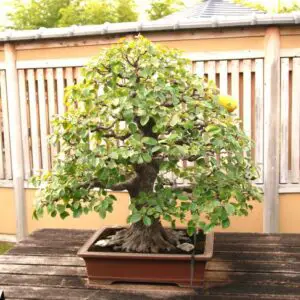
Certified “Precious bonsai” (Chinese quince)
Another example of a bonsai tree with historical significance is this tree, a Chinese quince, which is owned by several Japanese prime ministers. It is certified by the Nippon Bonsai Association as the first “precious bonsai” because of its historical significance.


